
 Over nine months away and Paris Brest Paris 2007 is already on many cyclists' minds. Click on the Brochure above to download it as a PDF or click here to jump to the ACP PBP website.
Over nine months away and Paris Brest Paris 2007 is already on many cyclists' minds. Click on the Brochure above to download it as a PDF or click here to jump to the ACP PBP website.I'm lazy, but I like to bike. I'm full of contradictions.

 Over nine months away and Paris Brest Paris 2007 is already on many cyclists' minds. Click on the Brochure above to download it as a PDF or click here to jump to the ACP PBP website.
Over nine months away and Paris Brest Paris 2007 is already on many cyclists' minds. Click on the Brochure above to download it as a PDF or click here to jump to the ACP PBP website.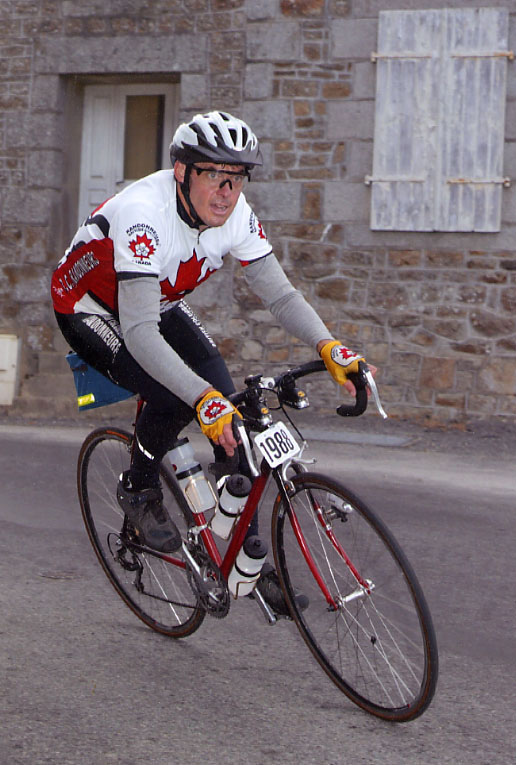
 I stumbled onto Nate's blog and found a pic of his stunning Kogswell G85 fixie. I don't need another bike. I especially don't need another randoneering bike. I love my Volae and I can tell we will be doing great things together in 2007. But, I must be honest with you, I am jealous of Nate's bike. It's elegant, simple and so functional - not to mention drop dead gorgeous.
I stumbled onto Nate's blog and found a pic of his stunning Kogswell G85 fixie. I don't need another bike. I especially don't need another randoneering bike. I love my Volae and I can tell we will be doing great things together in 2007. But, I must be honest with you, I am jealous of Nate's bike. It's elegant, simple and so functional - not to mention drop dead gorgeous. I have a Polar RS200 HRM. I use it day to day as a watch and I mount it to my Volae's handle bars when riding so I can see it easily. Keeping it on my wrist would make it hard to see - especially in cool weather when I am wearing several layers.
I have a Polar RS200 HRM. I use it day to day as a watch and I mount it to my Volae's handle bars when riding so I can see it easily. Keeping it on my wrist would make it hard to see - especially in cool weather when I am wearing several layers. I woke up this morning to a blanket of white loveliness covering the world as far as my eyes could see from my 11th floor apartment. It is beautiful indeed, but it is also cold and makes cycling a challenge. The biggest difficulty is not traction or cold weather. It's not slushy snow or incompetent drivers. It's not trashing my lovely bikes or having components freeze up. The biggest hurdle to overcome is what to do with a wet dirty drippy bike when I get back to my building?
I woke up this morning to a blanket of white loveliness covering the world as far as my eyes could see from my 11th floor apartment. It is beautiful indeed, but it is also cold and makes cycling a challenge. The biggest difficulty is not traction or cold weather. It's not slushy snow or incompetent drivers. It's not trashing my lovely bikes or having components freeze up. The biggest hurdle to overcome is what to do with a wet dirty drippy bike when I get back to my building?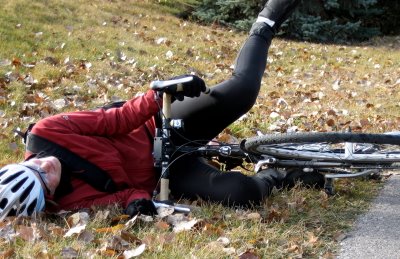
 It was -3 deg C this AM with an ice fog shrouding downtown Calgary. The view from inside my warm apartment was beautiful. I wanted to get out and bike a bit, but I just didn't feel like freezing my butt off. It is one thing to commute to work in sub-zero weather, but a fun ride is a whole different matter!
It was -3 deg C this AM with an ice fog shrouding downtown Calgary. The view from inside my warm apartment was beautiful. I wanted to get out and bike a bit, but I just didn't feel like freezing my butt off. It is one thing to commute to work in sub-zero weather, but a fun ride is a whole different matter! If you have a Volae or any other SWB recumbent and don't want to get chain lube on your right leg or clothing the Hostel Shoppe has a chain tube kit for you. The instructions on their website are pretty straight forward.
If you have a Volae or any other SWB recumbent and don't want to get chain lube on your right leg or clothing the Hostel Shoppe has a chain tube kit for you. The instructions on their website are pretty straight forward.


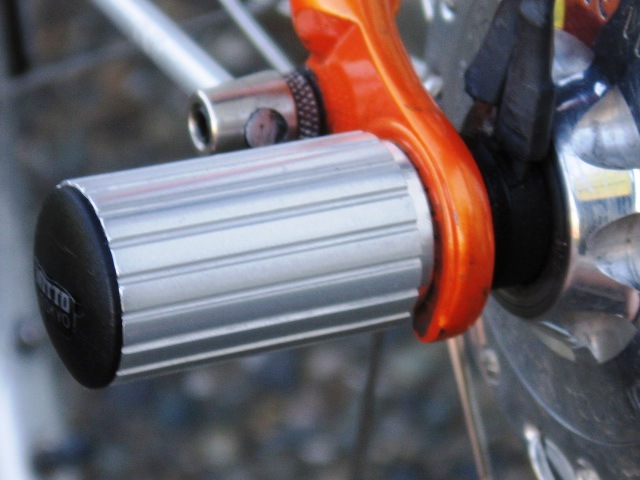 The skewer light mount from Nitto shown above is truly sweet. Functional and simple it puts the light down near the road. Some people seem to love lights down low and others only want them higher up. I have tried them at mid-fork level on my Surly LHT and found that position effective. I guess I won't be able to verify the effectiveness of the Nitto mount as I can't find anywhere to get one of these. If you happen to know of a source please leave me a comment.
The skewer light mount from Nitto shown above is truly sweet. Functional and simple it puts the light down near the road. Some people seem to love lights down low and others only want them higher up. I have tried them at mid-fork level on my Surly LHT and found that position effective. I guess I won't be able to verify the effectiveness of the Nitto mount as I can't find anywhere to get one of these. If you happen to know of a source please leave me a comment.
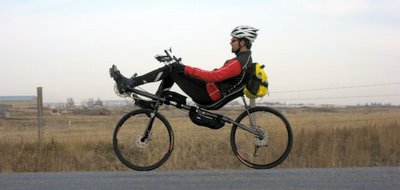

The Competitive Side of Randonneuring
By Jan Heine and Melinda Lyon
In 2003, the awards ceremony after Paris-Brest-Paris for the first time ignored the fastest male riders. While these riders had ridden faster than any randonneurs in PBP history, they were penalized two hours for various infractions of the rules. One of the officials, Gilbert Bulté, lists the transgressions: "Pushing officials at a control, urinating in towns, running numerous red lights and stop signs, being illuminated by an illegal support car, refusing to let my car pass, disrespect when I identified myself as an official." Robert Lepertel, the organizer of PBP, wrote in the newsletter of the French Cyclotouring Federation: "Never before have so many spectating cyclists and participants felt so compromised by this disrespect of the rules. The first 12 or 15 [...] have no respect for the organizers, the officials and all who make PBP a celebration of perseverance in the quest to complete this difficult ride. They do not deserve the name randonneur, as they do not know what riding unsupported means." (Cyclotourisme No. 518, 10/2003, p. 34.)
Strong words indeed, especially since the riders penalized did not feel that they did anything wrong or extraordinary. While they might not have followed every rule in the book, they felt that they had behaved as one would during a bicycle race. On the other hand, the organizers said that not only individual infractions had led to the penalty, but the spirit of the first riders evident from their disrespect of the rules. Clearly, there was a disconnect between the first riders and the organizers, about what PBP represents.
The organizers strongly feel that PBP is not a race, and that the spirit of randonneuring is threatened by these riders' behavior. But what is the spirit of randonneuring? The rules of PBP provide little guidance on this subject. BRM rules simply state that "brevets are not competitive events" (Article 12). But why is the time of each finisher listed, and why do the organizers of PBP recognize records and award trophies to those who are the fastest in their category? Doesn't that mean that it is race after all, for those who want to go fast? One can see why people might choose to disregard other rules as well in their quest to come first.
To examine this apparent contradic- tion between "not competitive" and awards for fastest riders, one has to look at the history of Paris-Brest-Paris. In 1931, randonneurs joined PBP, which had been a professional race since 1891. In the 1950s, all the other professional races were getting shorter. With the rather different training required for PBP, it no longer made sense for racers to bank a whole season on an elusive PBP win. PBP as a professional race died. The randonneurs took up the challenge.
Unlike the racers, who earned a living from the bike, the randonneurs rode for fun. They were proud to be amateurs -- lovers of cycling. The randonneurs were quite com- petitive at times (there is the Audax event for those who want non-competitive riding), but it was an amicable com- petition for the most part. Many of them remained involved in the sport for the rest of their lives, either as participants (the fastest sin- gle bike rider in 1956, Roger Baumann, went on to ride a record 10 PBP) or volunteers. In fact, Gilbert Bulté, the above-mentioned official, was on one of the two tandems that tied for first in 1956, beating all the single bikes. Roger Baumann, the aforementioned record-holder, was volunteering at Villaines-la-Juhel this year. The organizer of PBP 2003, Pierre Theobald, also com- peted in the late 1950s in various randonneur events.
Clearly, the organizers of PBP understand competition, and yet they don't see PBP as a race. The difference is subtle, and it has to do with civility. While racing is more like a battle, with only one rider coming out as a winner, randonneuring is all about the civilized enjoyment of cycling. Or as a non-randonneuring friend once put it: It is the quest for the perfect cyclist, any distance, any weather, self-sufficient.
This does not mean you have to go slow, or that you cannot be competitive. After all, PBP is about performance: You only get a medal if you finish within the time limit. For many riders, that means riding at the limit for up to 90 hours! And there is nothing wrong with challenging yourself and trying to better your previous times. Or even with trying to ride faster than others. But the important fact remains: Every finisher of PBP is a winner. Someone may be the fastest rider, even get a trophy, but they cannot claim to have "won" PBP. Everybody receives the same medal. The spectators understand this, and if anything, cheer on the last finishers more than the first ones.
The difference to racing is clear: Races defer to the fastest riders. By definition, potential winners of a race are more important than other riders. If a slower rider gets lapped in a circuit race, at the very least, they are expected to get out of the way of the faster riders, if they aren't pulled out of the race entirely. In a randonneur event, every participant is equally important. Fast riders cannot expect slower ones to make way for them at controls. Even the fastest are expected to behave in a civil and polite manner toward other participants, spectators and officials.
Randonneuring also is about self-sufficiency. Even though support cars are allowed at controls - mostly because it would be difficult to enforce a ban! - riders are expected to be able to ride by themselves, and to be prepared for the challenges of the road ahead.
Just as racing has its own ethics, such as frowning upon attacks when somebody has a flat or during a "neutral" bathroom stop, randonneuring does, too. These rules are unwritten, and different people may see them differently. Here is our take:
Of course, this spirit applies not only to PBP, but to randonneuring in general. Have fun, go fast if you like, challenge yourself and others, but remember: It is not a race!

 My ride last night turned out to be a lot harder than I had anticipated. I rode 104kms in 5hrs on the bike and 6hrs in total time - for an average speed of 21.1kph (on bike)/17.3kph (total time).
My ride last night turned out to be a lot harder than I had anticipated. I rode 104kms in 5hrs on the bike and 6hrs in total time - for an average speed of 21.1kph (on bike)/17.3kph (total time).
 Gear for a 100K ride temps 0-3 deg C, dry with 50-60% of the ride in the dark.
Gear for a 100K ride temps 0-3 deg C, dry with 50-60% of the ride in the dark.
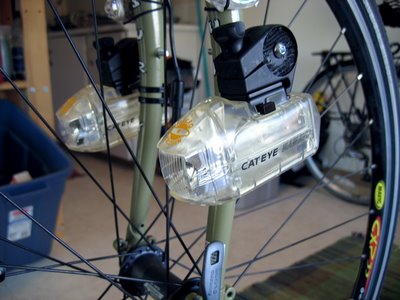 The Cateye fork mounted twin halogen HL-500II setup shown above (complete details are here) on my Surly LHT was what I planned to use for brevets. It is fine for night riding - even on unlit rural roads, but it has two serious drawbacks:
The Cateye fork mounted twin halogen HL-500II setup shown above (complete details are here) on my Surly LHT was what I planned to use for brevets. It is fine for night riding - even on unlit rural roads, but it has two serious drawbacks: I have decided to bite the bullet and get myself a SON dynamo hub and Solidlights 1203D 6w LED headlamp. This system provides a lot of light so I should be able to ride as fast as I am able at night and requires no batteries or spare bulbs. The cost of this system is not inconsiderable, but if you factor in the operating costs of battery headlights (batteries & bulbs) it breaks even after a season or two of randonneering.
I have decided to bite the bullet and get myself a SON dynamo hub and Solidlights 1203D 6w LED headlamp. This system provides a lot of light so I should be able to ride as fast as I am able at night and requires no batteries or spare bulbs. The cost of this system is not inconsiderable, but if you factor in the operating costs of battery headlights (batteries & bulbs) it breaks even after a season or two of randonneering. I'll mount the light to the derauilleur post at the front of my bike using a Terracycle light mount and a R&M handlebar mount. I may also consider a fork mounting option depending on how I like the intial setup.
I'll mount the light to the derauilleur post at the front of my bike using a Terracycle light mount and a R&M handlebar mount. I may also consider a fork mounting option depending on how I like the intial setup.
 I didn't set out to be different. If I could I would be riding the bike pictured above for my brevets. My Surly Long Haul Trucker handles well and it is my bike of choice for most rides. So why buy a recumbent you ask? Well it is simple after about 120kms my butt and shoulders are really uncomfortable. I have tried many saddles settling on a Brooks Champion Flyer and I have adjusted my position to try and improve the fit. For "normal" riding the Surly is plenty comfortable, but when you start to talk about distances of 200kms to 1200kms forget it. If I worked really hard and persevered a lot of discomfort I could complete a 200k brevet, but I wouldn't have fun. I also certainly wouldn't be lining up for a 600k brevet.
I didn't set out to be different. If I could I would be riding the bike pictured above for my brevets. My Surly Long Haul Trucker handles well and it is my bike of choice for most rides. So why buy a recumbent you ask? Well it is simple after about 120kms my butt and shoulders are really uncomfortable. I have tried many saddles settling on a Brooks Champion Flyer and I have adjusted my position to try and improve the fit. For "normal" riding the Surly is plenty comfortable, but when you start to talk about distances of 200kms to 1200kms forget it. If I worked really hard and persevered a lot of discomfort I could complete a 200k brevet, but I wouldn't have fun. I also certainly wouldn't be lining up for a 600k brevet. My Volae Expedition [Lrg frame & Med fiberglass seat] showed up on Friday the 13th - how lucky! The box was pretty beat up on one end, but the bike was packed very well and suffered no damage. Workmanship on the bike was excellent and I liked the paintjob a lot. Setup was a snap. Just install the front wheel, adjust the handlebars and the seat. With a bit of fiddling I was done in half an hour.
My Volae Expedition [Lrg frame & Med fiberglass seat] showed up on Friday the 13th - how lucky! The box was pretty beat up on one end, but the bike was packed very well and suffered no damage. Workmanship on the bike was excellent and I liked the paintjob a lot. Setup was a snap. Just install the front wheel, adjust the handlebars and the seat. With a bit of fiddling I was done in half an hour. I swapped out the stock 90mm stem for a 110mm Salsa stem to get my arms stretched out a bit more. I think I could even go to a 120mm or 130mm stem. Other than that the bike was comfortable to sit on, but the position felt pretty extreme in my living room. Although I have ridden recumbents before that was several years ago and all my riding lately has been on diamond frame bikes. My last SWB bent was a Vision R-40 and I recalled how squirrelly that bike felt. I was hoping the Volae would handle better. It was time for a test ride.
I swapped out the stock 90mm stem for a 110mm Salsa stem to get my arms stretched out a bit more. I think I could even go to a 120mm or 130mm stem. Other than that the bike was comfortable to sit on, but the position felt pretty extreme in my living room. Although I have ridden recumbents before that was several years ago and all my riding lately has been on diamond frame bikes. My last SWB bent was a Vision R-40 and I recalled how squirrelly that bike felt. I was hoping the Volae would handle better. It was time for a test ride. I started out in the parking lot at work planning on doing a bunch of riding there before trying it on the road. However, I pushed off and within 10 pedal strokes was clipped in and felt fine. Throwing caution to the wind I headed out on the open road immediately. The bike handled well and I quickly learned to be very light on the steering.
I started out in the parking lot at work planning on doing a bunch of riding there before trying it on the road. However, I pushed off and within 10 pedal strokes was clipped in and felt fine. Throwing caution to the wind I headed out on the open road immediately. The bike handled well and I quickly learned to be very light on the steering. I did two short rides to get used to the new bike before heading home along my normal commute route. This is a 25km highway ride with two long gradual climbs, several short steeper climbs and three long downhill sections. I have ridden this same road hundreds of times on my Cannondale R800 road bike and average between 26-30km/h. My average speed on the Volae was 28.3km/h. I was really happy because I was riding at night with marginal lights so I couldn't charge the downhills like I would on my commutes and the Volae is at least 5lbs heavier than my R800. On long gradual climbs I was able to keep a similar pace to my R800, but I was 2-4km/h slower on the steeper climbs. I assume that the better aerodynamics of the Volae allowed me to make up these deficits on the flats and downhills.
I did two short rides to get used to the new bike before heading home along my normal commute route. This is a 25km highway ride with two long gradual climbs, several short steeper climbs and three long downhill sections. I have ridden this same road hundreds of times on my Cannondale R800 road bike and average between 26-30km/h. My average speed on the Volae was 28.3km/h. I was really happy because I was riding at night with marginal lights so I couldn't charge the downhills like I would on my commutes and the Volae is at least 5lbs heavier than my R800. On long gradual climbs I was able to keep a similar pace to my R800, but I was 2-4km/h slower on the steeper climbs. I assume that the better aerodynamics of the Volae allowed me to make up these deficits on the flats and downhills.